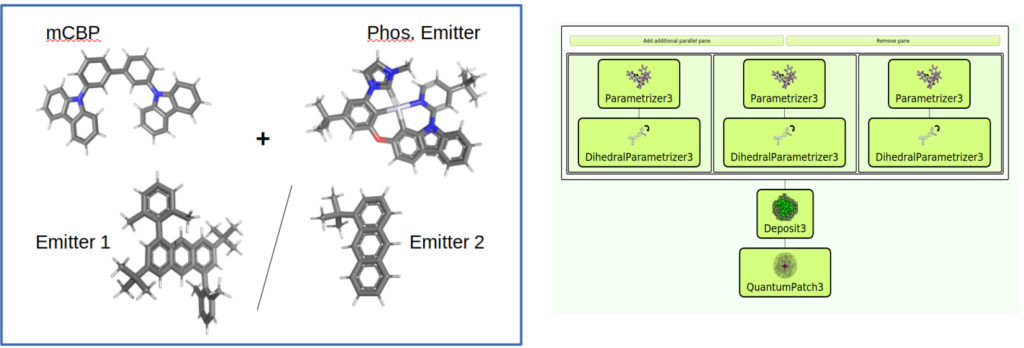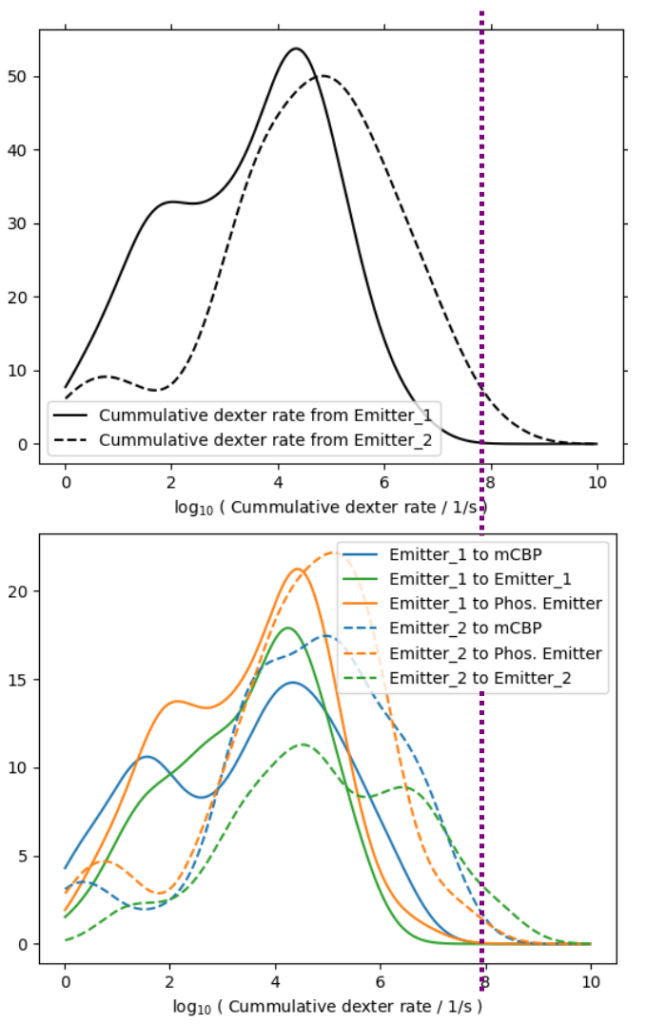In co-emission or hyperfluorescence systems, a fluorescent emitter is typically paired with a phosphorescent or TADF emitter and embedded into a host material. The goal of these setups is to transfer triplet excitons generated on the phosphorescent/TADF emitter to the fluorescent emitter where they can decay radiatively, providing narrow spectra with high quantum yield.
To maximize efficiency in these setups it is essential to suppress singlet-triplet conversion on the fluorescent emitter which can be facilitated by parastitic Dexter-transfer related processes. One way to achieve this is to dress the fluorescent emitter with side groups which have non-hybridizing states outside the homo-lumo gap, resulting in yet another dimension in the design of OLEDs and OLED materials. To efficiently assess the efficacy of a certain dressing configuration, you can use our software to compute Dexter escape rates from fluorescent emitters for a certain material combination, which directly correlate with the rate for dexter-mediated singlet-tripet conversion.
In this use-case we analyze shielding efficacy of two fluorescent emitters, depicted below. Both emitters are anthracene based molecules with larger side groups (Emitter 1) and only a single methyl sidegroup (Emitter 2). Both emitters are paired with a phosphorescent emitter and embedded in mCBP. For both emitters we executed the workflow depicted on the right:
- Parametrizer and DihedralParametrizer: Automated generation of forcefield parameters for mCBP, phosphorescent emitter and fluorescent emitter (either Emitter 1 or Emitter 2)
- Deposit: Generation of a thin film morphology consisting of mCBP (40%mol), phos. Emitter (30%mol) and fluorescent Emitter (30%mol), following our PVD simulation protocol, consisting of 2
- Computation of electronic couplings and Dexter couplings between all neighboring molecules in the thin film morphology in QuantumPatch, taking into account electrostatic environmental effects.

From the QuantumPatch output we computed an upper bound for Dexter escape rates from each fluorescent emitter molecule in the thin film by summing over all squared pairwise couplings to all neighboring molecules, which corresponds to the cumulative Dexter escape rate assuming resonance with all neighbors. The distribution of these rates is depicted on the right for both emitters as total rate to all neighbors (top) and resolved by species of the acceptor of the Dexter transfer. As a guide to the eye the typical fluorescent decay rate was added (purple line) at 108 s-1.

We find that the shielding of Emitter 1 leads to maximum Dexter rates below the fluorescent decay rate, while the minimalistic dressing of Emitter 2 results in Dexter rates more than one order of magnitude above the fluorescent decay rate. While these high rates make up only a small part of the distribution, they are the fastest within the distribution and may therefore strongly limit device efficiency.
When designing dresses for fluorescent emitters in co-emission systems it is challenging to design reasonably synthesizable molecules with sufficient shielding without modifying other functionally relevant molecular properties like excitation energies. This computational approach can aid by systematically screening various designs of an emitter to identify the sweet spot between chemical feasibility and functional efficiency.